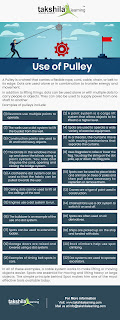What is a pulley
A pulley is a wheel with a flexible rope, cord, cable, chain, or belt that runs along its edge. Dots can be utilised alone or in groups to impart energy and movement. Bundles are the patches around the waist. The points are coupled to the shaft on its axis in the belt drive, and power is delivered between the shafts by an infinite belt that runs through the points.
A pulley is a mechanical device that makes it easier to lift heavy objects. The dots have a rotating wheel on an axle, which is connected to the centre of the wheel by a rope, cable, or chain. Fixed, moving, and compound spots are the three major types of spots.
A fixed point's wheel and axle are fixed in place, and the best example of one is a flag pole: as you pull down on the rope, the force is redirected via the point, and you lift the flag up.
Use of Pulley
 |
| Use of pulley infographic |
The pulley's initial purpose was to make lifting large objects simpler. A spot is a basic machine consisting of a wheel, rope, string, or chain.
Dots can be employed alone or in groups to carry persons or items in addition to lifting them. They can also be utilised to transfer electricity between shafts.
The following are some examples of pulleys:
a) Elevators operate by using numerous points.
b) A freight lift system that permits objects to be hoisted to a higher level is known as a point system.
c) The bucket is lifted from the well using a dot system.
d) Spots are utilised to control a variety of exercise machines.
e) Heavy things are lifted and held using construction points.
f) The curtains in a theatre are moved by moving mechanisms that separate the curtains.
g) The blinds in the windows are controlled by a point system that allows them to move up and down. You open and close the bridge system by hiding and disguising the rope.
Read more about
Visit Takshila Learning for Live online tuition classes
Comments
Post a Comment
Thank you we will contact ASAP.